|
November 8, 2018
Nation-Wrecking in the Retail Sector
U.S. Lowe's Consolidates Its Empire
PDF
  
Nation-Wrecking
in
the
Retail
Sector
• U.S. Lowe's Consolidates Its Empire
• For Your Information
Reducing Fatigue Among
Transportation Workers
• Practical Actions Are Needed, Not Rhetoric
Precarious Faculty
Jobs at Canadian Universities
• Crisis in Relations of Production Extends to
Intellectual Work
Northwest Territories
• Public Service Workers Wage Determined Fight
for Their Rights and Dignity
Quebec
• Serious Concerns About Automation of Mining
Processes - André Racicot, President, United
Steelworkers Local 9291, Abitibi, Quebec
• Drivers of Concrete Mixer Trucks Demand
Increased Safety for Themselves
and the Public
Rotating Strikes at
Post Office
• Postal Workers Confront Government
Intransigence on Major Issues
Nation-Wrecking in the Retail Sector
U.S. Lowe's Consolidates Its Empire
The U.S. retail conglomerate Lowe's has announced the
closure of 31 facilities that are part of its home improvement and
hardware operations in Canada along with the firing of hundreds if not
thousands of workers. The Lowe's press release did not give an
accounting of the number of workers to be fired. The closures include
27 retail stores, mostly RONA stores located in small towns or on land
in large cities that offer speculative profits from rising land prices.
Two of the stores to be closed are under the Lowe's brand. The U.S.
oligarchs say the regional administrative and support centres in
Mississauga, Ontario and St. John's, Newfoundland will also be closed.
Lowe's currently has 630 facilities in Canada. It will also be closing
a number of locations in the U.S.
Lowe's gained control of its competitor Quebec-based
RONA home depot chain and its workers in 2016,
consolidating 630 stores and 52,000 workers in Canada into
its empire. The U.S. giant controls 2,390 stores across North
America, daily buying the capacity to work of 310,000 workers to
operate its
business.
 Canadians had no control
over the decision to sell the RONA chain to Lowe's or the current one
to close 27 stores. The U.S. financial oligarchy has the power
over these decisions abetted by its political representatives in
government. The decision of what stores will remain or be eliminated is
based on the narrow consideration for
maximum return on the invested social wealth of the private interests
in control. No consideration is afforded to the well-being and security
of the workers involved and the broad requirements of nation-building
such as the retail and construction needs of the surrounding
communities. Small construction firms in particular may rely heavily
for their
supplies on the RONA stores slated for closure, especially in smaller
communities. Closing a nearby RONA may have the effect of forcing
buyers of construction material to travel farther to meet their needs
or pay more for what they require. Canadians had no control
over the decision to sell the RONA chain to Lowe's or the current one
to close 27 stores. The U.S. financial oligarchy has the power
over these decisions abetted by its political representatives in
government. The decision of what stores will remain or be eliminated is
based on the narrow consideration for
maximum return on the invested social wealth of the private interests
in control. No consideration is afforded to the well-being and security
of the workers involved and the broad requirements of nation-building
such as the retail and construction needs of the surrounding
communities. Small construction firms in particular may rely heavily
for their
supplies on the RONA stores slated for closure, especially in smaller
communities. Closing a nearby RONA may have the effect of forcing
buyers of construction material to travel farther to meet their needs
or pay more for what they require.
The press release coldly speaks of closing "27
underperforming corporate stores across the country, representing
approximately 3 per cent of its total retail network square
footage" but says nothing of the insecurity and worry this brings to
the human beings involved or to the wrecking of the economies of many
of the small towns
affected by the decision. The financial oligarchy uses the term
"underperforming" in the narrowest way, judging performance on the
number of customers and volume of sales per square feet and the profit
involved. The stores in fact may be performing an extremely valuable
retail service for the surrounding communities. To determine this would
require a human-centred investigation.
The Lowe's takeover of RONA in 2016 and the
further concentration of wealth and power in the hands of U.S.
oligarchs represent a consistent trend of the U.S. financial oligarchy
gaining greater control over all aspects of Canada's economic,
political and cultural life.
The financial oligarchy in control of the country's
social wealth, its means of production and circulation discourages any
economic activity based on the needs and well-being of the people and
nation-building. In fact, the downgrading of economic and cultural
opportunities in the smaller centres is a deliberate policy to force
people to
congregate in the largest metropolises. The oligarchs see the outlying
areas of Canada as mostly temporary targets for resource exploitation,
not as viable communities where the value workers produce is reinvested
to make the local economy all-sided and sustainable with the highest
level of culture available to residents.
The ruling oligarchs normally complain of the "high
cost" of doing business in the small centres and sing high praise to
the "over-performing" prospects for maximum profit and speculative big
scores in the big cities, such as is now occurring in housing and land
prices, but also in all features of the retail sector. Projects of
nation-building from
the past such as a national airline, railway, the Petro Canada oil
extraction and distribution company, the Canadian Wheat Board, Canada
Post and others, which served the country as a whole and not just the
largest metropolises have either been privatized and abandoned or are
under serious threat.
The issue facing Canadians is how to gain the political
power to deprive the financial oligarchy of its power of control over
the economy and politics of the country, and begin a modern
nation-building project with the working people in command.

For Your Information
The Lowe's website says its stores serve "more
than 18 million customers a week in the United States, Canada and
Mexico. With fiscal year 2017 sales of $68.6 billion, Lowe's
and its related businesses operate or service more than 2,390 home
improvement and hardware stores and employ over 310,000
people.... Lowe's Canadian business, together with its wholly owned
subsidiary, RONA inc., operates or services more than 630
corporate and independent affiliate dealer stores.... In Canada, the
companies have more than 28,000 employees, in addition to
nearly 5,000 employees in the stores of RONA's independent
affiliate
dealers."
The November 5 press release from its North
Carolina headquarters says by the end of 2019, Lowe's will close a
total of 31 locations, including 27 Lowe's and RONA stores in
BC, Alberta, Ontario, Quebec, and Newfoundland and
Labrador, and 20 locations in the U.S.
The stores in Canada to be shut:
British Columbia
RONA Columbia Square 105-1015 Columbia
Street, New Westminster
Alberta
RONA Calgary Douglasdale, 11520 -- 24th
St. SE
Reno-Depot Calgary West, 12330 Symons Valley Rd. NW
Ontario
RONA Mississauga Westdale Mall, 1133
Dundas St. W.
RONA Mississauga Lakeshore, 1692 Lakeshore Rd. W.
RONA Sault Ste. Marie, 132 Black Rd.
RONA Sudbury, 943 Barry Downe Rd.
RONA Peterborough, 1575 Chemong Rd.
RONA Kingston, 1452 Bath Rd.
RONA Lakefield, 178 Water St.
Lowe's North York, Centerpoint Mall, 6600 Yonge St.
Lowe's Sault Ste. Marie 248 Northern Ave.
Quebec
RONA Ste-Clotilde, 335, Route 209,
Sainte-Clotilde-de-Chateauguay
RONA Iberville, 870, boulevard d'Iberville,
Saint-Jean-sur-Richelieu
RONA L'Assomption, 723, boulevard L'Ange-Gardien
RONA Granby Moeller, 788, rue Moeller
RONA Ste-Rose 134, boulevard Sainte-Rose, Laval
RONA Rivière-des-Prairies, 9200, boulevard
Maurice-Duplessis, Montréal
RONA Rouyn-Noranda, 1200, rue Mantha, Rouyn-Noranda
RONA Ange-Gardien, 194, rue Principale, Ange-Gardien
RONA Saint-Elzéar, 100, rue du Parc Industriel, Saint
Elzéar
Newfoundland
RONA Conception Bay South,
Killigrews, 825 Conception Bay Highway
RONA Goulds, 53-59 Main Highway
RONA St. John's, 1297 Topsail Rd.
RONA St. John's, 60 O'Leary Ave.
RONA St. John's, 710 Torbay Rd.
RONA Bay Roberts, 239 Conception Bay
The company says it will also shut regional support
centres in Mississauga, Ontario and St. John's, Newfoundland along with
a
truss plant in St. John's and a block plant in Kamloops, BC. Aside from
the RONA stores, Lowe's Canada will also close two Lowe's stores,
Réno-Dépôt, Ace Canada, Dick's Lumber, and
Contractor First corporate
and affiliated dealer locations within its Canadian retail network, as
well as its online offerings and parcel delivery service.

Reducing Fatigue Among Transportation
Workers
Practical Actions Are Needed, Not Rhetoric

On October 29, the Transportation Safety Board
(TSB), the federal government agency responsible for transportation
safety in Canada, released its Watchlist 2018.
Every year, the TSB publishes a Watchlist which
identifies key safety issues it has determined need to be addressed to
make Canada's transportation system safer. The inclusion of issues on
the list is determined by investigation reports and the TSB's safety
concerns and recommendations.
The TSB investigates accidents and makes safety
recommendations concerning four modes of transportation: aviation,
rail, marine and pipelines.
The TSB has included the issue of workers' fatigue
among aviation, rail and marine workers in Watchlist 2018. This is
a
problem which has become rampant and is one of the main aspects of the
fight of transportation workers for their health and safety, which is
intrinsically linked with the health and safety of the public.
In her remarks to the press to present
Watchlist 2018, TSB Chair Kathy Fox said, among other things:
 "I'll close today with a
brief look at an issue that has appeared in over 90 TSB
investigations over the years: fatigue. It's pervasive, especially in
a 24/7 industry like transportation, where rail, marine, and
flight crews can work long and irregular schedules -- sometimes in
challenging conditions or across multiple time zones. That,
in turn, means crews don't always get enough restorative sleep, which
can impair human performance. To fix this, there needs to be a profound
change in attitudes and behaviours, both at the management and
operational levels. That means taking steps such as: awareness
training; fatigue-management plans; modernizing duty-time regulations
for
train crews, marine watchkeepers, and pilots; and making sure that, in
general, work-rest rules are based on science -- and not just the way
things have always been done." "I'll close today with a
brief look at an issue that has appeared in over 90 TSB
investigations over the years: fatigue. It's pervasive, especially in
a 24/7 industry like transportation, where rail, marine, and
flight crews can work long and irregular schedules -- sometimes in
challenging conditions or across multiple time zones. That,
in turn, means crews don't always get enough restorative sleep, which
can impair human performance. To fix this, there needs to be a profound
change in attitudes and behaviours, both at the management and
operational levels. That means taking steps such as: awareness
training; fatigue-management plans; modernizing duty-time regulations
for
train crews, marine watchkeepers, and pilots; and making sure that, in
general, work-rest rules are based on science -- and not just the way
things have always been done."
Transportation unions responded positively to the TSB's
recommendations. In an October 30 press release, the Air Canada
Pilots Association (ACPA) endorsed the inclusion of pilot fatigue on
the Watchlist.
"For years, our pilots have been advocating for
stronger rest rules that will protect Canadian passengers and crew from
fatiguing work conditions," said Captain Matt Hogan, Chair of ACPA's
Master Elected Council. "Between this Watchlist and U.S. National
Transportation Safety Board findings that fatigue was a contributing
factor in its
investigation into Air Canada Flight 759, it's time for the
government to take action."
Air Canada Flight 759 was involved in a
potentially tragic incident at San Francisco's main airport in
July 2017 when an Air Canada plane arriving from Toronto nearly
landed on a secondary runway where four large carriers filled with
passengers were awaiting takeoff. Only four metres separated Air
Canada's Airbus A320 and
one of the four airplanes parked on the runway. The pilots were able to
divert their plane at the last second to avoid a collision, which,
according to the experts, would have been one of the greatest
catastrophes in Canadian airline history. The U.S. National
Transportation Safety Board (NTSB) found Air Canada pilot fatigue to be
a main factor in
the near disaster (notwithstanding the mental acuity displayed by the
pilots to avert the imminent collision). The NTSB report stated that
the
pilot in charge of the flight had been awake for 19 consecutive
hours and his co-pilot for 12. Neither had napped during the
flight, contrary to Transport Canada's current regulations.
"With the 2018 Watchlist, Canada's Transportation
Safety Board puts the government on notice," said Milt Isaacs, CEO of
the ACPA. "It's not enough to pay lip-service to aviation safety. The
government must take real action to close the two-hour gap between its
proposed rest rules and the limits recommended by NASA science."
The pilots are highly critical of Transport Canada's
proposed regulations which would allow pilots to fly up to 10.5
hours at night on long-haul flights. The proposals compromise sleep,
both when workers are returning to home base after an overseas flight
and for duty periods that begin at night. Pilots have demanded that
duty periods
for flights in the evening be set at 8.5 hours of flight time.
Canada's Federal Minister of Transportation, Marc
Garneau, did not show any statesmanship in his response to the TSB's
recommendations. Far from it, he responded in the typical fashion of
the cartel parties in Parliament when responding to questions or
criticism, by saying:
"The Transportation Safety Board plays a very important
role in ensuring that Canada's transportation sector remains one of the
safest in the world, and I welcome the publication of their 2018
Watchlist. I am pleased to see that the hard work done by Transport
Canada has resulted in good progress on many fronts since the last
edition
in 2016.

"Transport Canada continually examines existing fatigue
management requirements to determine if amendments are required to
update the regime and works in partnership with key federal partners
and stakeholders in developing any options. The department is proposing
new pilot fatigue rules to make air travel safer for Canadians, with
the
intent of publishing the final regulations in the Canada Gazette, Part
II, in 2018....
"The Department is improving safety management and
oversight in all modes by evaluating its oversight tools to ensure
their continued effectiveness. Transport Canada works actively to
enhance the safety of all Canadians by improving the safety of air,
rail and marine sectors and the transportation of dangerous goods."
This rhetoric diverts from the seriousness of the
situation which the TSB has identified. It specifically diverts
attention from the sharp criticism by transportation workers, including
pilots, of the so-called safety management system which is
non-prescriptive and is part of the self-regulation of the
transportation industry, and of the new pilot
fatigue rules that Transport Canada is planning to impose. Rhetoric
does not make real life and real problems disappear. It makes problems
worse as those in positions of authority are sweeping problems under
the carpet and caving in to the demands of the private monopolies
narrowly seeking their maximum profit at all costs, including putting
air
transport
workers, passengers and the public at risk of injury and death.
When Minister Garneau speaks of "good progress on many
fronts" he is referring to the TSB's decision to remove some issues
from the Watchlist, such as the issue of transportation of flammable
liquids by rail. This is a questionable recommendation by the TSB which
actually shows how pervasive the neo-liberal dictate is. The
recommendation flies in the face of the broad discourse in society on
issues of safety. The concern of the people over transportation of
highly flammable liquids by rail remains very strong and is actually
growing as rail transport of such materials is growing.
In any case, the inclusion of transportation workers'
fatigue on the Watchlist is significant because transportation workers
are waging a serious fight on that issue at this time.
Workers are demanding practical action on the issue of
fatigue reduction, based on science and their own experience and the
solutions they are putting forward to deal with the problem.


Precarious Faculty Jobs at Canadian
Universities
Crisis in Relations of Production Extends
to Intellectual Work

Ontario community college faculty participate in October 15, 2018 rally
against Bill 47 which will remove equal pay for equal work provisions
for
part-time and contract workers
contained
in current Ontario labour legislation.
A recent study reveals that precarious work among
university faculty is now 53.60 per cent of all positions.
In 2016-17, 38,681 faculty appointments, or 53.60 per
cent, were contract positions compared to 33,490 tenured and
tenure-track appointments. Among contract faculty part-time
appointments
predominate, accounting for nearly 80 per cent of all contracts
in 2016-17.
The Canadian Centre for Policy Alternatives obtained
the data through Freedom of Information requests sent to 78
Canadian universities and produced the report "Contract U -- Contract
faculty appointments at Canadian universities."[1]
The data reveals Quebec relies on contract faculty more
than any province, with 61 per cent of faculty on contract
followed
by BC at 55 per cent and Ontario at 54 per cent. The study
found 13 universities in Canada use contract appointments for more
than two-thirds of all faculty appointments.
The report writes that many contracts are limited in
scope and very short in duration comprising a single course for one
semester or a month to four months, depending on the terms. "Other
contracts are full-time and cover longer periods, such as two to three
years. But all of them are characterized by long-term uncertainty for
the people in
these positions," the report states.
Irregular work for many is a precarious arrangement,
which has become a norm throughout the Canadian working class with
multiple types of irregular insecure paid relations of employment:
part-time, temporary, casual, and contract either arranged between an
individual worker or their collective and an employer, or indirectly
through an
employment agency. In addition are the multiple insecure forms of
self-employment. Precarious work more often than not results in low
pay, few to no benefits, and little stability or security for the
worker.[2]

Proportion of contract faculty by province (CUPE)
"Our findings suggest the significant reliance on
contract faculty in Canadian universities is a structural issue, not a
temporary approach to hiring, and we know that impacts workers in the
sector and the quality of education students receive," says Chandra
Pasma, co-author of the study and a Canadian Union of Public Employees
researcher.
Pasma added, "[The high rate of contract work] may be a labour
relations strategy, in that you not only keep wages and benefits low
when people are on contract, but it's sort of a disciplinary measure.
When people have tenure it's very difficult to let them go. When people
are on contract, you don't even need to fire them; you just don't renew
their contract."
For university faculty, the insecurity and prevalence
of this type of employment, the report highlights, is having a negative
impact on workers and on the quality of education students receive.
Contract work frequently means poverty and economic insecurity. The
report reads, "Per-course rates can be as low as $5,000, which
means that
an individual can teach a full course load at some universities and
still be living in poverty. A survey of contract faculty in Nova Scotia
found that the insecurity of employment was the number one challenge
and source of stress for contract faculty.
"Similarly, a survey of contract faculty in Ontario
revealed that two-thirds experienced 'considerable personal strain' due
to the short-term nature of their employment. A national survey of
contract faculty found that more than half say their ability to make
long-term plans such as having children or purchasing a home is
impacted by the
contract nature of their employment. Without job security, contract
workers can have difficulty obtaining a bank loan, signing a rental
agreement, or getting a mortgage. Contract faculty are frequently
excluded from professional development, collegial opportunities, and
institutional support for research, which can leave them feeling
isolated and
unsupported.[3]
"When instructors are only informed a few weeks -- and
in some cases, only a day or two -- before the semester begins that
they will be teaching a course, it is difficult for them to ensure that
course material is up-to-date and that all necessary resources, such as
textbooks, are in place for students."
The conditions in which contract faculty are forced to
work can have an impact on their ability to deliver the highest quality
education. For students, the precarious situation for their professors
often means less access to faculty. The report states, "Sometimes
contract staff are not given access to an office on campus, requiring
them to hold
meetings with students in borrowed or public spaces."
The data reveals a majority of contract faculty are
women who "tend to be younger but for the most part are no longer
students themselves. Between one-half to two-thirds of contract faculty
have a Ph.D. The majority have been teaching on contracts for five
years or more. For many teaching part-time or on contract is solely
because
they can't
find permanent, full-time academic employment. According to a recent
national survey by the Canadian Association of University Teachers,
more than half of contract faculty want a tenure-track or permanent
appointment. Cutting off contract faculty email addresses the moment
the semester ends or not being able to track down a contract professor
whose contract was not renewed also makes it more difficult for
students to get reference letters."
 The report also says, "The
increase in the number of contract positions also has an impact on
permanent faculty. Reducing the number of faculty who are involved in
committee work or administration means that the burden of service work
is disproportionately higher on the remaining faculty members. For
permanent faculty and other
academic workers, such as lab instructors and teaching assistants, the
lack of presence by contract faculty (who may have no office space on
campus or who have to leave for another job immediately after class)
can also mean increased workloads responding to student questions and
concerns." The report also says, "The
increase in the number of contract positions also has an impact on
permanent faculty. Reducing the number of faculty who are involved in
committee work or administration means that the burden of service work
is disproportionately higher on the remaining faculty members. For
permanent faculty and other
academic workers, such as lab instructors and teaching assistants, the
lack of presence by contract faculty (who may have no office space on
campus or who have to leave for another job immediately after class)
can also mean increased workloads responding to student questions and
concerns."
The report does not give a definitive answer as to why
contract work has grown exponentially in recent times venturing only to
suggest a variety of reasons. These include public funding cuts for
post-secondary education during the anti-social offensive and an
antagonistic stance of university administrations towards their
employees including
faculty. This period corresponds with a rapid rise of tuition fees.
Those in charge of buying the capacity to work of
employees have introduced myriad ways to decrease the claim of workers
on the value they produce. Forcing contract work on those who sell
their capacity to work puts them in a weak position in terms of
organizing their fellow workers to demand a price for their capacity to
work that meets
modern standards and can give them cultured living and working
conditions and allow them to do their work at the highest level of
quality.
The situation exposes a general sharp deterioration
in the relations of production between those who sell their capacity to
work and those who buy it. The growing prevalence of contract work
reveals the necessity for the working class to step up its organizing
and resistance in defence of its rights and claim on the value it
produces within
the existing relations of production. It reveals also the need for
renewal of the ensemble of human relations including importantly the
necessity for new relations of production to empower the working class
as the human factor and decision-maker at the workplace with a decisive
say on terms and conditions of employment.
Notes
1. For the complete report
click
here.
2. The CCPA writes, "No Safe Harbour: Precarious Work
and Economic Insecurity Among Skilled Professionals in Canada shows
professionals across the country are not immune to the hallmarks of
precarious work: no steady income, no pension, no benefits, no sick pay.
"Even full-time work isn't a buffer against
precarity: 26 per cent of precarious professionals work full-time,
though most go contract-to-contract (37 per cent) or work part-time (34
per cent). The majority (60 per cent) of precarious professionals don't
have a pension plan or RRSP, nor do they get sick pay.
"The report finds precarious professionals in both the
private (40 per cent) and public (30 per cent) sector. Precarious
professionals are in all professions, but they're concentrated in three
occupational categories: education (28 per cent), health care (18 per
cent), and business, finance and administration (19 per cent). The
majority of precarious
professionals are women (60 per cent) and there is a higher incidence
among professionals aged 55 and up."
"For more than two decades," the report reads,
"academic workers, unions, and faculty associations have been raising
concerns about a shift within universities from full-time, permanently
employed faculty to faculty hired on contracts. Some of these contracts
are limited in scope and very short in duration: a contract for a
single course for a
single semester (or a month to four months, depending on the terms).
Some of these contracts are full-time and cover longer periods, such as
two to three years. But all of them are characterized by long-term
uncertainty for the people in these positions."
"A growing number of precarious workers are in highly
skilled, professional positions. The post-secondary sector reveals
trends that are taking place in the broader labour market."
For the complete report, click
here
3. For reports on the struggle of Ontario College
teachers for their rights and terms of employment agreeable to
themselves click
here for past issues of Ontario Political Forum.

Northwest Territories
Public Service Workers Wage Determined Fight
for Their Rights and Dignity
The 4,000 public employees employed by the
Government of the Northwest Territories (GNWT) are waging a determined
fight for significant improvements to their working conditions to meet
their needs in this northern environment where the cost of living is
much higher than in southern Canada. They are also tackling the problem
of attracting and retaining workers. These workers provide services
that are essential to the functioning of society -- health care,
various trades, road maintenance, highways and infrastructure, health
and safety programming for the Territories, staffing the colleges, etc.
While they contribute immense value to the economy and their work is
essential
for the well-being of society, they are not recognized as such by the
GNWT. Instead, they are actually considered a "cost" and an impediment
to the funding of infrastructure projects under consideration by the
GNWT.
The GNWT has declared an operational surplus
of $200 million for this year and over $100 million in
operational surpluses in the last three years, surpluses that have
largely been achieved through an anti-social offensive against public
services. This includes, according to the Union of Northern Workers
(UNW) which represents these
workers, the elimination of 150 public service positions in the
last three years and the extension of the use of relief workers who do
not have scheduled hours of work and do not have leave banks
(accumulated paid time off contributed by other workers) or pensions.
The President of the UNW Todd Parsons told Workers'
Forum that the GNWT has declared that every penny of its
declared
operational surplus would be spent on infrastructure while those who
actually provide the infrastructure would get nothing.
The union has been negotiating for over two-and-a-half
years, with a period of mediation at the end of October, but very
little progress has been made at the bargaining table on the two most
important issues for the workers, wages and job security.
The UNW proposed a three-year agreement with a three
per cent wage increase per year while the government wanted a four-year
agreement with zero per cent, zero per cent, one per cent, and 1.1 per
cent wage increases over the four years. The union reports that the
GNWT is now
asking for a five-year agreement, still with zero per cent increases in
the first two years.
In terms of job security, the union is asking for
consolidation of layoff language and for the conversion of term
positions that extend past 24 months into fulltime indeterminate
positions. The GNWT wants to replace fulltime indeterminate positions
with relief workers. This is what it is already doing in Corrections
and Health. The
GNWT also wants to be allowed to use relief workers in all areas of the
GNWT, which the UNW does not accept.
Also, the Northwest Territories have what is called a
Northern Allowance. This is an allowance that is being paid to
employees in NWT Communities to offset the higher cost of living and
travel. The allowance is part of the UNW-GNWT Collective Agreement.
According to the union, the Northern Allowance has not increased in
Yellowknife
in over 11 years, while in a lot of the communities it has even
gone down. The union is asking for a significant increase in the
allowance. The union is also asking that there be no contracting out of
bargaining unit work.
Workers are pointing out that the cost of living in
their region, especially the costs of housing, are significantly higher
than in Southern Canada. The refusal of the GNWT to improve their
living and working conditions makes it much harder attracting and
retaining public service workers.
The union is now in a legal position to strike, and has
served 48-hour notice to the employer.
"We have said to our members that we are going to do
what we can to avoid going on strike before Christmas in order to allow
them to prepare," said Todd Parsons to Workers' Forum. "We are
not going to go on strike unless we are being provoked and we have
given a definition of what it would mean to be provoked. We are
going to go on strike if the Minister responsible for the public
service changes our terms and conditions, and under the legislation up
here they can unilaterally do that. They cannot lock us out, but they
can unilaterally change our conditions. We also said that we would go
on strike if the employer starts disciplining our members for showing
support for the bargaining team. Our members have started to wear
orange laces and high visibility lanyards, and we heard that the
employer recently told our members that they were not allowed to wear
these things in support of the bargaining team. This kind of job action
is perfectly legal. If the employer starts disciplining our members for
that,
this could drive us to go on strike."
Todd also explained that the process governing labour
relations is very peculiar in the Northwest Territories. "The process
up here is very lengthy. We do not have a Labour Board in the NWT and
do not fall under the jurisdiction of the Canada Labour Code either. We
can make our complaints only to the Minister responsible for the public
service. We do not have a provincial labour code. We have territorial
employment standards that govern minimum standards for everybody except
the public service. We are kind of in limbo land here, and this is the
first time in almost 50 years that we have been in a legal strike
position and members have confirmed that with an
almost 70 per cent strike mandate."
Todd said that besides wearing high visibility laces
and lanyards, workers are involved in a campaign of media and radio
ads, along with putting up signs, similar to election signs, on
people's homes,
as well as talking to members of the Legislative Assembly.
"It is really a big fight. We are fighting on behalf of
our members to obtain a fair deal which provides stability for their
families so that they can thrive in this northern environment."

Quebec
Serious Concerns About Automation
of Mining Processes
- André Racicot, President, United
Steelworkers Local 9291, Abitibi, Quebec -

Demonstration September 19, 2016 demands the reinstatement of
André
Racicot who had been suspended by mining company Iamgold in Abitibi for
defending the health and safety
of mining workers.
One of our major concerns right now is the issue of the
automation of machinery in underground operations in the mining sector.
Our concern is two fold. There is a lack of government regulation
regarding this new technology. There is also the issue of the jobs that
will be taken away from mine workers.
We have been talking to the Labour Standards, Pay
Equity and Occupational Health and Safety Commission (CNEEST) for two
or three years now. We have argued with them that the lack of
regulations concerning this equipment is worrisome. These operations
include teleoperated equipment as well as autonomous and
semi-autonomous
equipment. These different processes involve a high level of
automation. In the case of teleoperated equipment, we are referring to
equipment operated by means of remote controls. The problem we are
facing right now is that the technologies are advancing but the
regulations are not keeping pace. This situation is preferred by the
mining
companies because they like to have a free hand and not have too much
regulation in the way that would restrict what they can do. They want
to decide for themselves what changes will be made. In the past, when
these things were left to the employers, the workers paid a very high
price, particularly in terms of their health and safety.
In the case of autonomous or
semi-autonomous equipment, what happens if the equipment does not stop
when it is supposed to stop? Is it going to detect a worker who is in
its way? If an accident occurs it can be fatal. It must be understood
that there is always human intervention somewhere. Take the example of
semi-autonomous equipment where the operator controls the underground
equipment from the surface. In theory, there are no human beings who
should be in the path of the equipment in the pit. We know very well
that it is impossible to ensure that there is no human being in the
areas in which the equipment operates. It takes mechanics to fix
these machines. It takes electricians. It takes human beings to fix
that equipment. The worker must enter a danger zone and the worker must
approach the machine. The equipment has a brake system that is operated
from the surface but what guarantee is there that the brake system will
work? At the moment, we are kind of at the mercy of the big
multinational companies that use this equipment everywhere and who
decide themselves the protocols that govern their use.
In the case of teleoperated equipment, you can have an
operator who is thousands of kilometres away from the mining operation;
someone in India or Bangladesh can be operating equipment in a mine in
Abitibi. If we get a regulation it will not be a regulation that
applies in the country where the operator is located. This creates a
legal
vacuum. The union raised this issue with CNESST and the Commission so
far does not seem to know what to do with such a problem. We have
started to put pressure on the government to have the operation of this
equipment regulated in Quebec and, if operated from another country, to
have the operator subject to the same regulations.
The technology that makes these long-distance
operations possible exists. We just have to think of U.S. drones that
are used to drop bombs in Iraq or elsewhere that are operated from
Arizona.
We have serious concerns about health and safety,
regarding the interaction of this equipment with humans.
The other concern is jobs. The dream of the mining
companies is to operate the mines without human beings. They dream of
it because they would have no wages to pay, no pension plans to fund,
etc. In addition, equipment does not speak out. It does not present
demands. It does not take sick leave. We are very concerned about job
losses.
Mining companies say that this is true, there will be fewer
mining workers, but there will be more people repairing and operating
the equipment. We know very well however, in light of what is
happening in the world, that the strategy of mining companies is to use
operators who are no longer mining workers. These are people who
have never set foot in a mine in their lives. They are able to operate
technology, much like a video game. We believe that over time the
people who will operate this equipment will more and more be people who
have no connection with the mining industry.
We are proposing regulatory changes to ensure that
qualified people, who have knowledge of miners' work underground,
operate this equipment. There is a case in Fermont, in northern Quebec,
where
semi-autonomous drilling machines are being used. The operator works
from the head office while the drilling machine is in the pit. When the
operator leaves his
post to go for lunch the machine is teleoperated while he is away. This
process with this kind of automation already exists in the mines in
Quebec.
The unions are there to protect the health and safety
of workers and to protect their jobs.

Drivers of Concrete Mixer Trucks Demand Increased
Safety for Themselves and the Public

Concrete mixer truck drivers working for the five sections of Demix
Concrete in Montreal area
hold an extraordinary general meeting, October 8, 2018 in Laval. (FIM-CSN)
Since June, the 200 concrete mixer truck drivers
working for the five sections of Demix Concrete in the Greater Montreal
area have been calling for measures to correct problems created through
the implementation of a new "Optimizer" computer system. The system is
aimed at managing concrete deliveries to construction sites. The
workers are members of five unions affiliated with the Manufacturing
Industry Federation (FIM-CSN). Demix Concrete is a division of CRH
Group Canada Inc., itself a division of CRH plc, a global building
materials monopoly based in Ireland, with facilities primarily in
Europe and North America.
The recently activated Optimizer system connects each
concrete mixer truck driver to a distribution plant via an electronic
tablet. Optimizer analyzes in real time the routes to be taken and the
response times required for the delivery of concrete by dictating which
routes the drivers are to take. In some instances the system proposes
routes
through densely populated neighbourhoods, without any regard to zone
designations such as "No Trucks," or to actual restrictions under the Highway Safety Code.
The Optimizer system experiences regular breakdowns,
which prevent workers from doing their work and, in particular, from
contacting the dispatch centre, thereby increasing their stress levels.
In addition, the system regularly requires that workers
exceed their maximum 50 hour work week, further undermining their
vigilance and the reflexes needed as drivers of heavy loads, besides
having to sacrifice time with their families. The workers are
demanding that they be able to stop for an hour for a sorely-needed
break, in
accordance with the law. However, the Optimizer system actually
prevents them from doing that.
Concrete mixer truck drivers are denouncing the fact
that the Optimizer system was implemented without consulting them, even
though it directly affects their working conditions,
including their health and safety. During a general assembly
meeting in early October, the workers unanimously rejected the
corrective measures proposed
by the company as being entirely inadequate. They have mandated their
union leaders to directly call on senior management in Toronto to find
solutions to the problem, which reflect the views and experience of the
drivers themselves.
It should be noted that the drivers are not currently
in negotiations for their collective agreement. Such significant and
detrimental changes for them and for the population have simply been
imposed by the company. This is unacceptable and the workers reject
these unilateral changes.

Rotating Strikes at Post Office
Postal Workers Confront Government
Intransigence on Major Issues
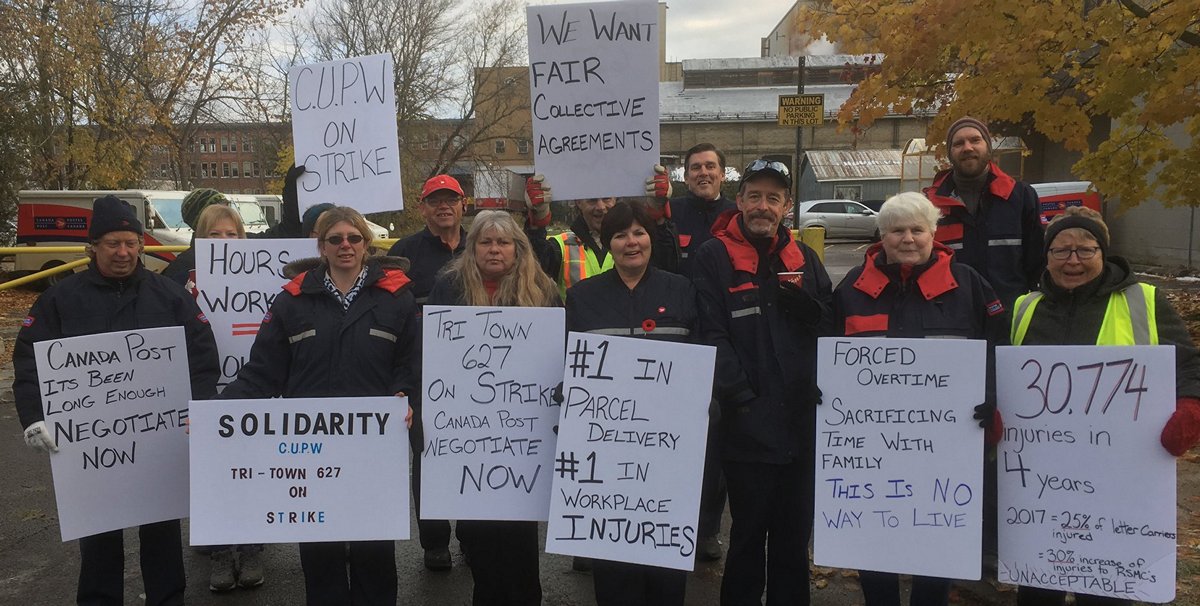
Tri-Town (Cobalt, Haileybury, New Liskeard), Ontario
Thousands of postal workers across the country continue
to press
their just demands for working conditions commensurate with their work
in the face of government intransigence.
 "After more than ten months
of negotiations, the intervention of
two mediators and two weeks of rotating strikes, Canada Post's true
colours are emerging," said Mike Palecek, Canadian Union of Postal
Workers (CUPW) National President. "The lofty rhetoric of wanting to
work with us to reach fair agreements for our workers is turning out
to be nothing more than smoke and mirrors. It needs to be said: Canada
Post talks the talk, but doesn't walk the walk." "After more than ten months
of negotiations, the intervention of
two mediators and two weeks of rotating strikes, Canada Post's true
colours are emerging," said Mike Palecek, Canadian Union of Postal
Workers (CUPW) National President. "The lofty rhetoric of wanting to
work with us to reach fair agreements for our workers is turning out
to be nothing more than smoke and mirrors. It needs to be said: Canada
Post talks the talk, but doesn't walk the walk."
CUPW has called on a national overtime ban for both of
its major
bargaining units at Canada Post. Postal workers, no matter what their
job at Canada Post, will not work more than an eight-hour day and not
more than a 40-hour week. "Overburdening, overtime and overwork
are all
major issues in this round of bargaining. Until Canada
Post negotiators' address it, we can solve it for ourselves," said
Palecek.
CUPW members are still without agreements for the Urban
Postal
Operations and Rural and Suburban Mail Carriers (RSMC) bargaining units
after almost a year of negotiations.
The union also informed on November 7 that
Minister of Labour Patty
Hajdu has extended the appointment of Morton Mitchnick as a mediator,
for a period of four days.
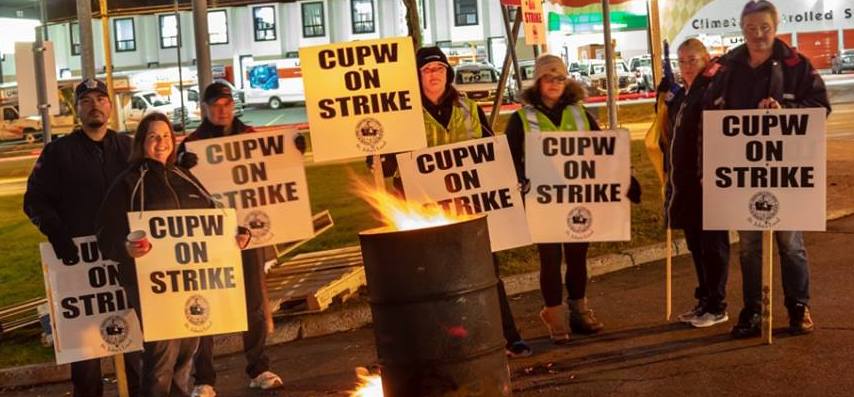
St. John's, Newfoundland.
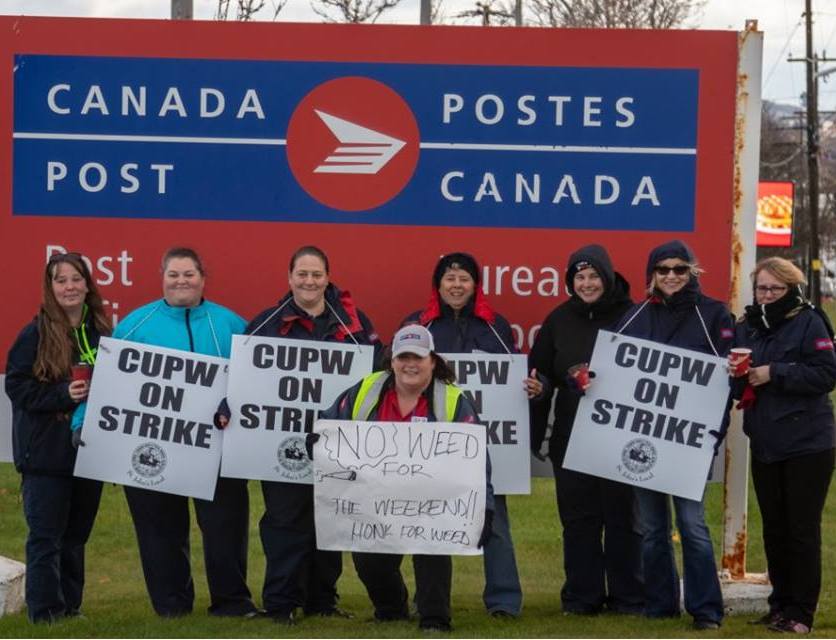 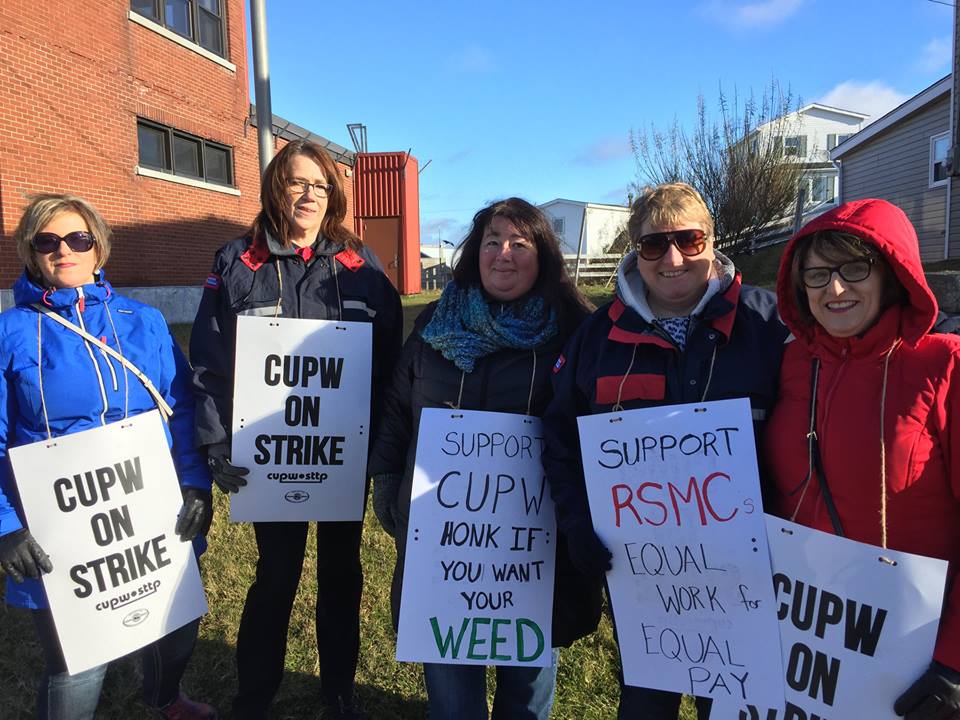
St. John's, Newfoundland; Chanel-Port Aux Basques, Newfoundland

Gander, Newfoundland

Chateau Richer, Quebec
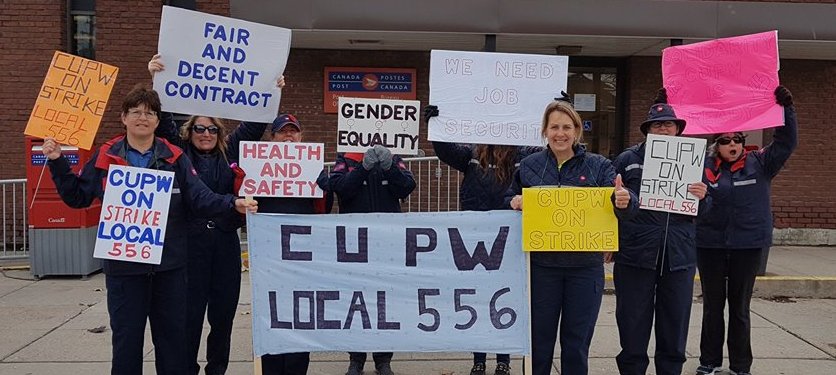
Gananoque, Ontario
 Welland, Ontario Welland, Ontario
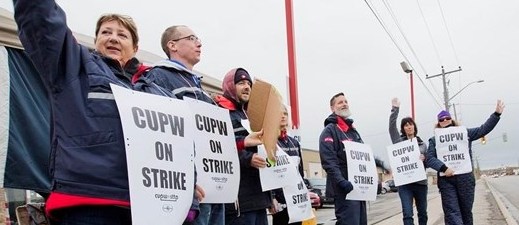
St. Catharines, Ontario

Solidarity rally at city hall, London, Ontario
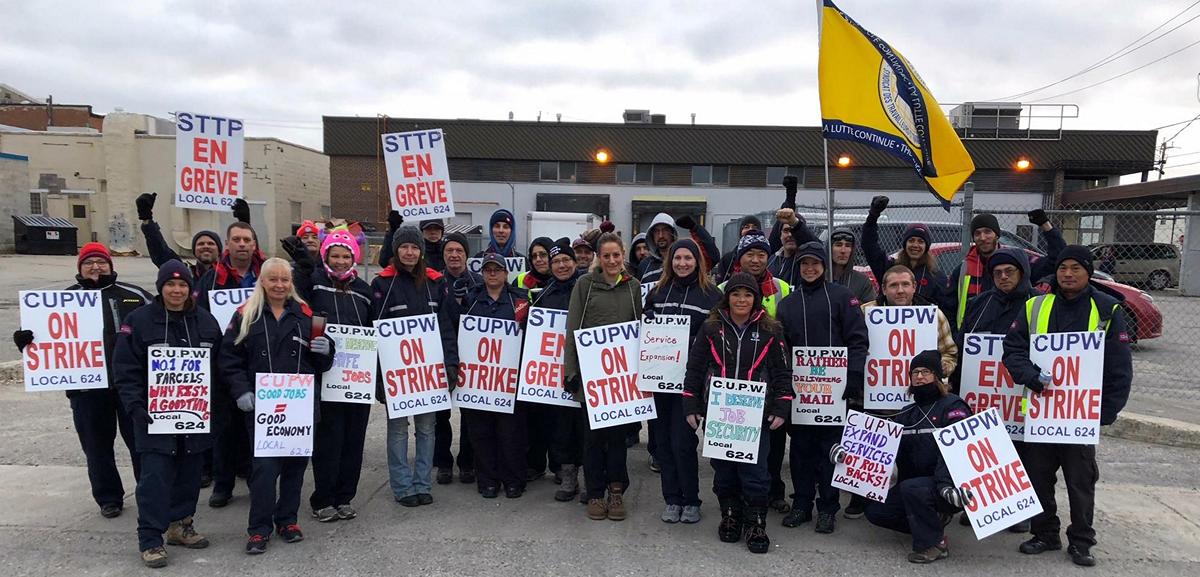
Timmins, Ontario
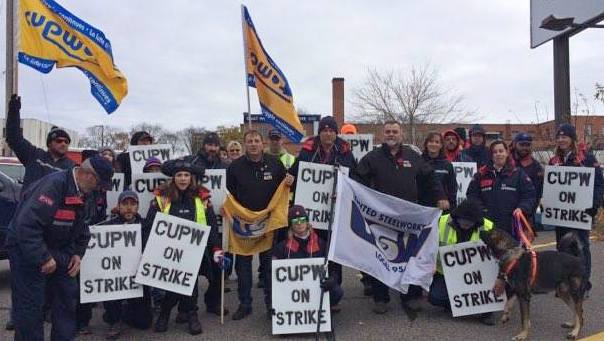
Sault Ste. Marie, Ontario

North Bay, Ontario
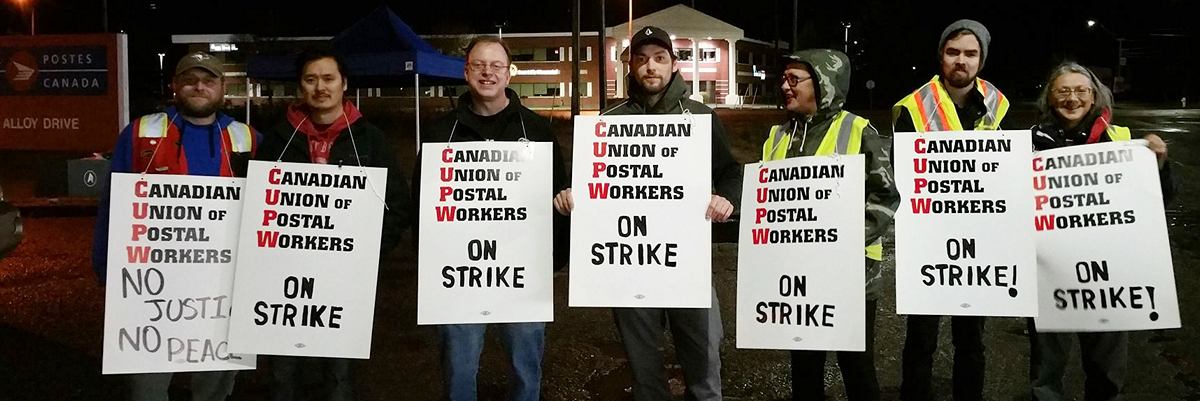
Thunder Bay, Ontario

Edmonton, Alberta solidarity picket.

Nisku, Alberta, RSMC picket
 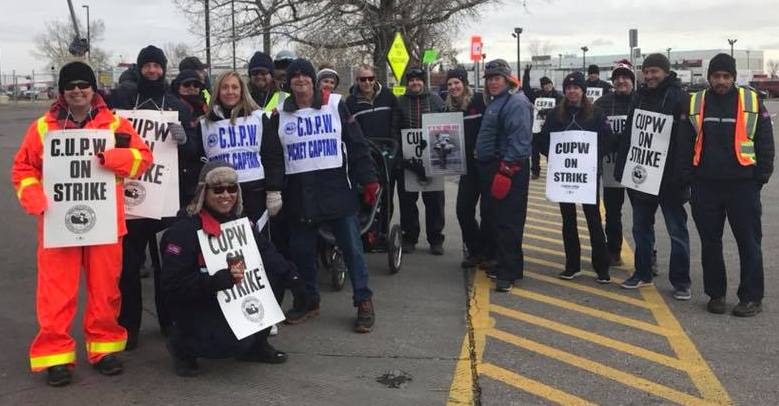
Calgary, Alberta

PREVIOUS
ISSUES | HOME
Website: www.cpcml.ca
Email: office@cpcml.ca
|

